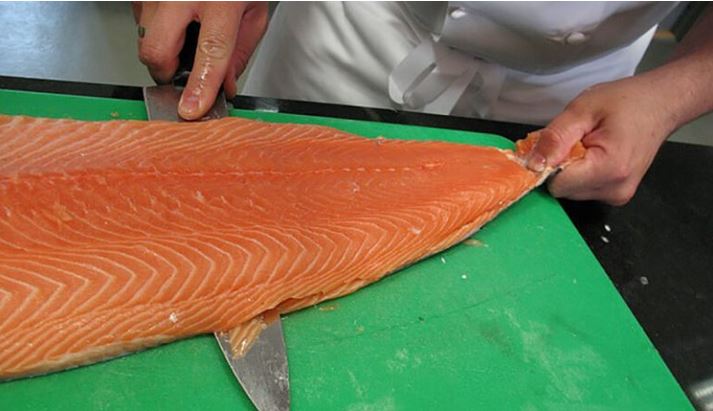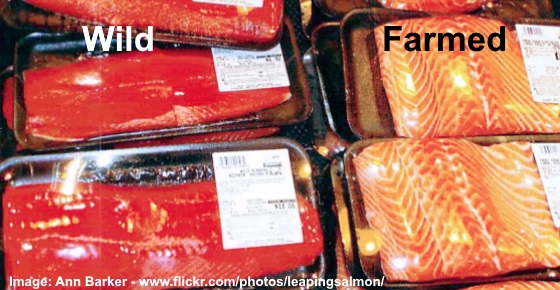Beware: U.S Salmon May be Crawling with Japanese Tapeworm, Say Scientists

A recently published study by the U.S. Centers for Disease Control and Prevention (CDC) found that Alaskan salmon could be infected with Japanese broad tapeworm, a parasite previously believed to only infect fish in Asia.
According to CDC’s study, salmon caught anywhere along the Pacific coast of North America and Asia could be infected with the Diphyllobothrium nihonkaiense Tapeworm Larvae.
Researchers warn that based on their findings, any salmon caught along the North American Pacific coast may have the parasite. The concern is that if you eat the fish undercooked or raw, you could become a host to this gruesome parasite.
These new findings are based on an examination of 64 wild salmon from five different species, caught off the Alaskan coast. Samples of pink salmon were found to harbor Japanese broad tapeworm larvae – some were 8–15 mm long.
The Japanese Tapeworm – Diphyllobothrium Nihonkaiense
According to the CDC, there are four types of Pacific salmon that could host the Japanese broad tapeworm:
- chum salmon (Oncorhynchus keta)
- masu salmon (O. masou)
- pink salmon (O. gorbuscha)
- sockeye salmon (O. nerka).
Consuming raw or undercooked salmon, particularly in dishes such as sushi, sashimi and ceviche can greatly increase the risk of tapeworm infection. The CDC says the parasites can be destroyed when fish is adequately cooked or completely frozen.
It is worth noting that when fish such as salmon are commercially caught, they are placed on ice for the journey to port. But this does not freeze the fish, it only refrigerates them so the risk of infection remains. In order to kill the tapeworm the fish need to be completely frozen.
Tapeworms could be lurking in your sushi
If you eat salmon sushi at a restaurant or a store, you should assume it is unsafe unless you know the salmon has been frozen.
Additionally, you need to cook the salmon well in order to kill the parasite.
Tapeworms can Grow up to 30 feet
Tapeworms, including the Japanese version can grow to 30 feet inside a human digestive tract.
The symptoms of a tapeworm in humans are not always apparent because they may often be mild, with symptoms largely attributed to other conditions by doctors.
The journal Clinical Microbiology Reviews reports that some people with a tapeworm lodged in their intestine might never show any symptoms at all. Other people may only have occasional mild signs of an intestinal tapeworm infection and attribute them to something else.
Tapeworm Symptoms in Humans
Some of the symptoms of tapeworm infection include abdominal pain, gas, diarrhea, fatigue, itchy red rash, anal itching, unexplained weight loss, and vitamin B12 deficiency. In rare cases, massive infection can cause an intestinal obstruction or gallbladder inflammation.
There could be other symptoms, and I mentioned them in my detailed article about tapeworms in humans.
How the Infestation is Treated
If you suspect you have intestinal parasites, your doctor will be able to do a stool test to confirm it and use prescription medication that is most effective against your intestinal parasite.
Related: Tapeworms in Humans: Symptoms and Treatments (Pictures Included)
Should You Consume Farmed Salmon?
Wild salmon is just that. It’s wild. You can find it living freely in oceans, lakes and rivers. It’s high in omega 3 fatty acids, a type of polyunsaturated fatty acid that may reduce heart disease, behavioral problems, depression and inflammatory conditions2. It also has a range of other health benefits.
Although farmed fish is also a good source of omega 3 fatty acids, eating it may do you more harm than good.
Farmed fish are grown in fish-farms called aquacultures, where half of the fish in the world comes from1. They contain harmful additives and chemicals that you should stay away from and this is something that I’ve already mentioned in a previous article.
What’s the Problem with Farmed Salmon
Farmed Salmon Contains Toxic Pollutants and Chemicals
According to a scientific research published in the Environmental Health Perspectives, farmed salmon contains more contaminants than wild salmon4. The contaminants were below approved levels, but were still higher than what is considered to be safe by the Environmental Protection Agency.
Toxic chemicals such as POPs, or persistent organic pollutants, can greatly affect human health. Medical studies found that they are associated with obesity and type 2 diabetes5 and an increased risk of stroke in women6. According to a research published in the Journal of Nutrition, farmed raised salmon contained 10 times the amount found in wild salmon in some areas7.
Eating farmed fish also gives you a higher risk of developing cancer, according to that study. Your cancer risk from eating farmed fish is three times higher than when you eat wild salmon. The researchers concluded that eating more than a meal of farm-raised salmon per month, depending on its country of origin, could slightly increase the risk of getting cancer later in life.
A 2003 study from the Environmental Working Group (EWG) found that seven out of ten farmed salmon purchased in grocery stores in San Francisco, Washington, DC, and Portland were contaminated with polychlorinated biphenyls (PCBs) “at levels that would be safe to eat no more than once a month.” PCBs are persistent, cancer-causing chemicals that were banned in the United States in 1976.
A study published in CBS News found that farm raised salmon contained high levels of 13 pollutants including dioxins and PCBs11.
Dioxins and PCBs are highly toxic. Dioxins can cause reproductive and developmental problems, damage the immune system, interfere with hormones and also cause cancer.
According to the WHO’s International Agency for Research on Cancer, dioxins were classified as a known human carcinogen12. Although dioxin was not shown to affect genetic material, we should not accept these types of additives in our food.
Farmed Salmon is Exposed to Antibiotics and Pesticides
Since farmed fish are kept in overcrowded nets, it’s easy for them to spread infections to each other. In these conditions, a virus can quickly spread and kill off a massive amount of fish.
Farmers don’t like that, so antibiotics are given to farmed fish to prevent them from getting sick and dying off.
According to a research published in the Environmental Microbiology, large amounts of antibiotics are being mixed with fish food and served to farmed fish8.
You are taking a risk when you eat fish that have been fed antibiotics. A study published in the Journal of Antimicrobial Chemotherapy stated that antibiotics that are used in animal feed may cause infections in humans9.
Wild fish are not exposed to antibiotics and therefore are safer to eat. That’s one more reason to go wild.
Farmed Salmon is Artificially Pink
Compare a piece of farmed salmon to a piece of wild salmon and you will notice a difference in color. Wild fish contains an antioxidant and an anti-inflammatory compound known as astaxanthin, which is responsible for giving salmon its bright red color3. It’s interesting to note that this compound is also one of the reasons why salmon is one of the top foods against wrinkles.
Wild salmon get their astaxanthin fill by eating plankton. But farmed fish don’t have this luxury. Instead, they are fed pellets that contain GMO corn and animal byproducts.
If you spot a piece of farmed fish that looks better than its wild counterpart, don’t be fooled. Farmed fish is given artificial color additive to make it look better.
Farmed Salmon is Less Nutritious Than Wild Salmon
One of the reasons why you eat salmon in the first place is because it’s good for you. So which fish has the highest nutritional content? Here’s a hint. Nature does it best.
A portion of wild salmon contains approximately 130 calories less than farmed fish when comparing small cuts10,13. It contains half the amount of fat, three times more vitamin A and eight times more vitamin D per 100 gram serving10,14. Farmed fish is also 3 times higher in saturated fat.
How to Compare Between Wild and Farmed Salmon
So how can you tell whether a salmon is wild or farm-raised?
Farmed salmon is light pink — almost orange — and has a flatter shine, without the rich hues of red.
Wild salmon is also very lean, so the fat marks, those white stripes you see in the meat, are very thin.
If the fish is pale pink with wide fat marks, the salmon is farmed.
Avoid Atlantic salmon, as typically salmon labeled “Atlantic Salmon” currently comes from fish farms.
Salmon – the Bottom Line
On paper wild fish wins all the rounds. It contains a higher nutritional content. It does not contain antibiotics or artificial additives. And most importantly, it is obtained naturally from its environment.
Avoid farm fish if you can. But there are only so many fish in the sea. There may be times when farm fish is your only option. Remember that farm fish is still high in omega 3 fatty acids and other nutrients that we need. But you may want to limit the number of days you eat farmed fish per month.
Be mindful when ordering salmon at restaurants. Unless the menu specifically states that the fish is wild, chances are it’s farmed.
Fresh, wild fish also tastes better than frozen, so enjoy it while you can.
Why You Should Never Eat Tilapia and Other Farmed Fish
Resources:
(1) https://en.wikipedia.org/wiki/Aquaculture
(2) http://journals.rcni.com/doi/abs/10.7748/ns2004.08.18.48.38.c3668
(3) http://www.ncbi.nlm.nih.gov/pmc/articles/PMC3083660/
(4) http://www.ncbi.nlm.nih.gov/pmc/articles/PMC1257546/
(5) http://www.ncbi.nlm.nih.gov/pubmed/21966444
(6) http://www.ncbi.nlm.nih.gov/pubmed/24428778
(7) http://jn.nutrition.org/content/135/11/2639.full
(8) http://www.ncbi.nlm.nih.gov/pubmed/16817922
(9) http://jac.oxfordjournals.org/content/53/1/28.full
(10) http://ndb.nal.usda.gov/
(11) http://www.cbsnews.com/news/wild-salmon-healthier-than-farmed/
(12) http://www.who.int/mediacentre/factsheets/fs225/en/
(13) http://ndb.nal.usda.gov/
(14) http://bc.ctvnews.ca/
(2) http://journals.rcni.com/doi/abs/10.7748/ns2004.08.18.48.38.c3668
(3) http://www.ncbi.nlm.nih.gov/pmc/articles/PMC3083660/
(4) http://www.ncbi.nlm.nih.gov/pmc/articles/PMC1257546/
(5) http://www.ncbi.nlm.nih.gov/pubmed/21966444
(6) http://www.ncbi.nlm.nih.gov/pubmed/24428778
(7) http://jn.nutrition.org/content/135/11/2639.full
(8) http://www.ncbi.nlm.nih.gov/pubmed/16817922
(9) http://jac.oxfordjournals.org/content/53/1/28.full
(10) http://ndb.nal.usda.gov/
(11) http://www.cbsnews.com/news/wild-salmon-healthier-than-farmed/
(12) http://www.who.int/mediacentre/factsheets/fs225/en/
(13) http://ndb.nal.usda.gov/
(14) http://bc.ctvnews.ca/

